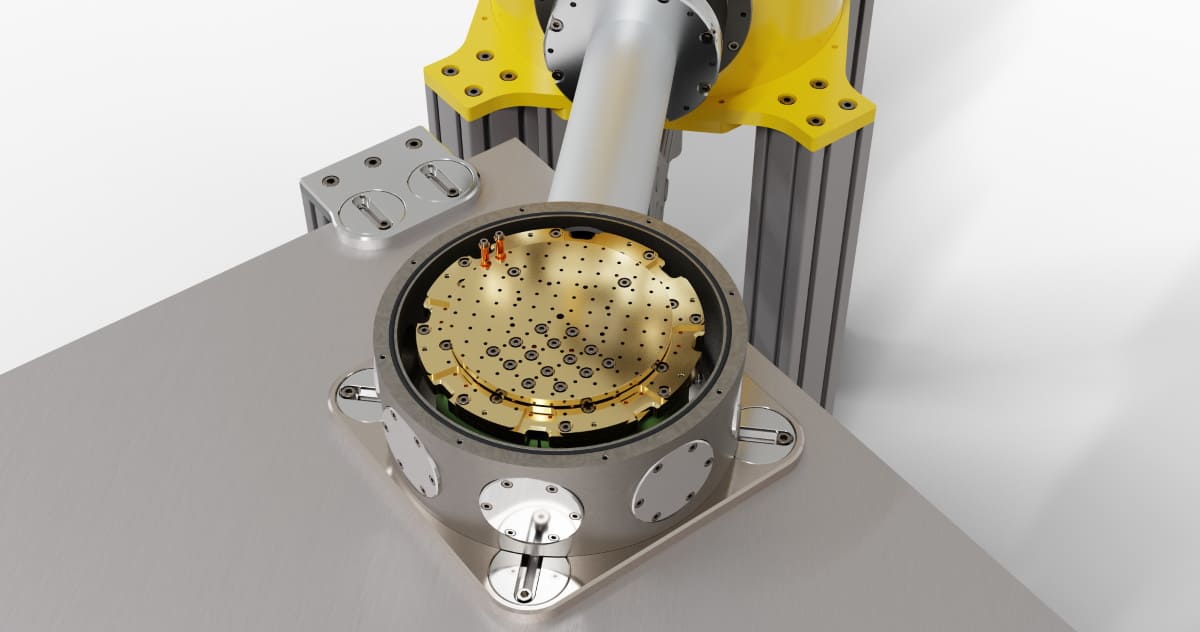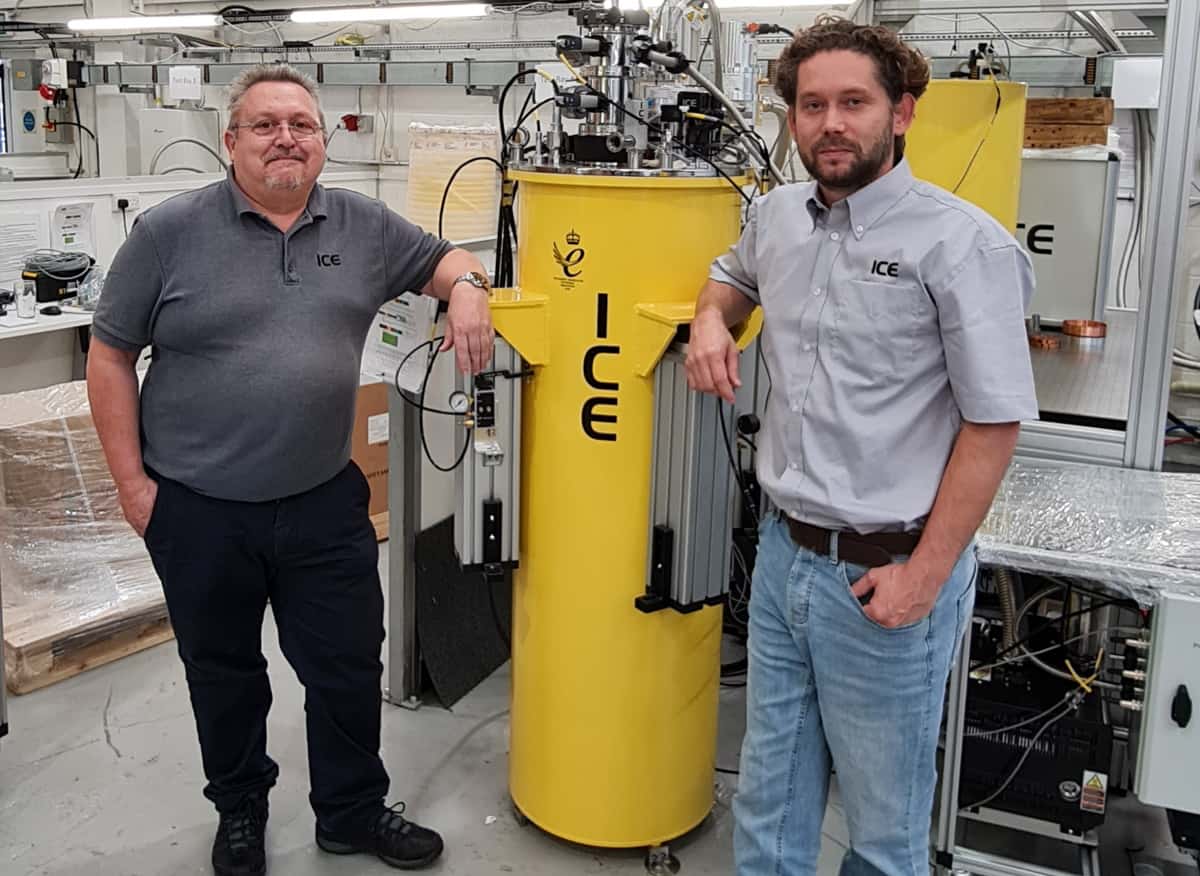Ultralow-vibration performance and operational flexibility are defining features of ICEoxford’s latest closed-cycle cryostat

While the mercury was hitting record highs in the UK over the summer, development engineers at ICEoxford were bunkered down in the cool of the R&D laboratory, putting the finishing flourishes to the company’s latest offering for ultralow-temperature regimes. The product in question, the DRY ICE DYAD, is a closed-cycle cryostat system capable of cooling to a 1.7 K base temperature whilst providing cutting-edge vibration isolation and flexible optical-access options to the sample space.
For context, ICEoxford’s core competency is the design and development of high-end cryogenic systems to support experimental studies across diverse applications within the physical sciences – from quantum computing and quantum optics to high-temperature superconductivity and scanning probe microscopy (SPM). What sets the company apart, though, is a relentless focus on customer service and collaborative innovation, claims Paul Kelly, chief technical officer at ICEoxford. “Put another way,” he adds, “we work directly with scientists to understand their requirements at a granular level, giving them confidence that we can deliver the optimum system versus their budget and technical specifications.”
Prioritizing stability and flexibility
That collaborative model of product development underpins the technical specifications of the DRY ICE DYAD – not least when it comes to ultralow-vibration performance (at <10 nm). Key to success here is the sample unit being held separately on an optical table, such that it is isolated from the cold head and the main body of the cryostat (and connected only by a soft thermal link to further reduce vibration). “Our design approach is to decouple the cryostat completely from the sample environment,” explains Kelly. “The cryostat sits on the laboratory floor, with the sample space located on the adjacent optical table.”
In fact, stability provides one of the over-arching design themes of the DRY ICE DYAD. “While our scientific customers all have unique requirements,” notes Kelly, “they’re all ultimately looking for stability along three main coordinates. Think vacuum stability – a clean, reliable vacuum. Think temperature stability – from the very low base temperature up to 300 K. Think mechanical stability – because in quantum research even the smallest vibrations can cause the quantum effects to fail.”
Operational flexibility is another design consideration that’s front-and-centre in the DRY ICE DYAD. A case in point: the end-user can switch the sample-space environment between a top-loading exchange-gas module and a vacuum module within a couple of hours – an arrangement that ensures versatile cryogenic cooling to align with the often-conflicting research priorities in busy laboratories.

In terms of specifics, the top-loading exchange-gas module is a patented design that allows the sample to be changed without warming the main body of the cryostat, thereby enabling a 2 h sample cooldown time. Sample manipulation and rotation are also possible in up to six axes along with high-numerical-aperture optical access and magnetic fields up to 9 T.
Meanwhile, the sample-in-vacuum module includes a 150 mm diameter cold plate onto which the sample is mounted (with a direct thermal link to the cryostat). The sample space is accessed by lifting the outer vacuum plate and radiation shield, while the top-loading sample module (a probe-based unit) enables sample changes without heating up the entire system. Integration of low-temperature nanopositioners and up to three objectives facilitates sample movement and manipulation.
“The cryostat is really set up to handle two different types of experiment – under exchange gas and under vacuum,” notes Kelly. “The exchange gas allows fast turnaround and preliminary sample studies that are, more often than not, a precursor to longer-duration experiments [days or even weeks] under vacuum.”
Made-to-measure magnetism
Cooling aside, superconducting magnets are an integral part of the DRY ICE DYAD system, with ICEoxford offering a range of solenoid, split-pair and vector-rotate magnets up to 9 T field strength. While studies of magnetic properties at ultralow temperatures are a given, many scientists also want to carry out simultaneous optical investigations of their materials – not so easy if the sample is sat within the large coil of a solenoid magnet.
One option, for example, is to load the sample into the bore of a split-pair magnet to allow laser spectroscopy experiments in transmission or reflection mode. The use of two- or three-way vector-rotate magnets provides further flexibility, with the latter able to generate a magnetic field in three discrete directions. In this way, it is possible to keep the sample stationary while the magnetic field is varied around it – a key feature when studying a specific plane within a crystal lattice or if the heat generated by sample rotation is a source of interference for small-scale electrical conductivity measurements.
Another notable feature of the DRY ICE DYAD is the emphasis on automation, with LabVIEW-based software used to control and monitor temperature. “This has been developed with the customer in mind,” concludes Kelly, “to reduce the set-up and turnaround time of the system while increasing laboratory productivity.” What’s more, it’s possible to add features to the software such as integrated control for the superconducting magnet as well as automating the top-load and probe cool-down.
Specific customizations include an option for up to six additional ports around the optical system to enable end-users to integrate DC wiring, coax cables or optical fibres on an as-needed basis. Users can also request up to five optical windows of varying diameter in a range of materials.
“Product innovation is ongoing with the DRY ICE DYAD,” concludes Kelly. “We already have 1.6 K and 1.5 K base temperatures in our sights on the development roadmap.”
